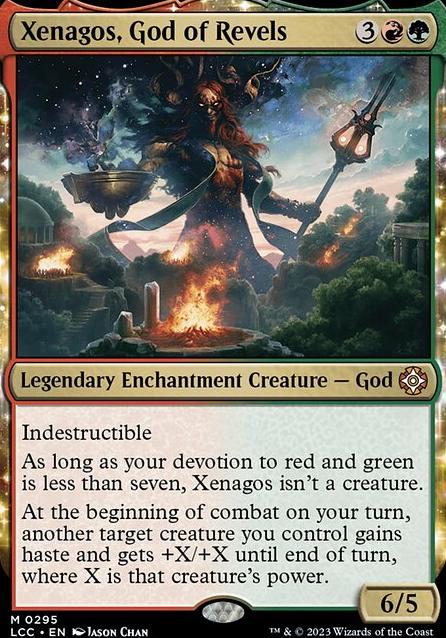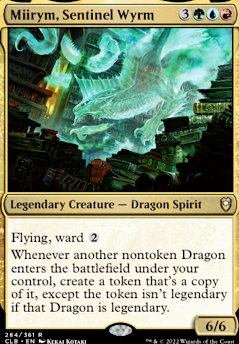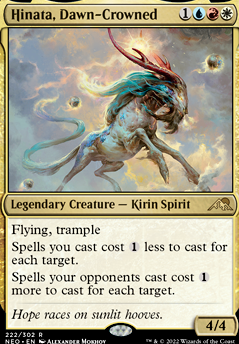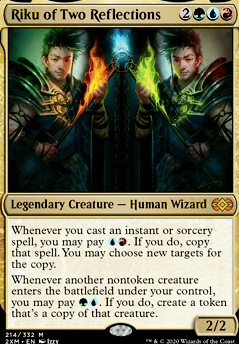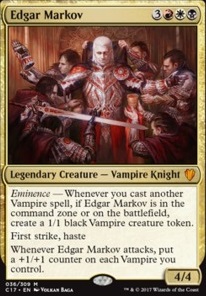Bramble Sovereign: This dryad from Battlebond is a fantastic utility creature for Xenagos. With only six legendary creatures (Godo, Bandit Warlord, Urabrask the Hidden, Etali, Primal Storm, Ilharg, the Raze-Boar, Drakuseth, Maw of Flames, Ghalta, Primal Hunger) in our deck, the token created by Bramble Sovereign will almost always remain. Additionally, this creature provides a layer of politics at the table as we can select an opponent to create a token of a creature that entered their battlefield. Our deck does not have many creatures with enter the battlefield triggers (only three: Terastodon, Woodfall Primus and an ineffectively copied Godo, Bandit Warlord - there's only one equipment in the deck). However, adding to the mana cost of almost any of our creatures to create a token of it is immensely powerful. Excluding Xenagos, God of Revels and Bramble Sovereign, our board state is improved by creating a token copy of each of our 19 remaining creatures. Sovereign is an auto-include!
Urabrask the Hidden: This praetor's haste-granting ability is awesome, but tapping down each of our opponents' creatures as they enter the battlefield adds a layer of defense. In a dedicated Gruul deck, seldom are we promoting defense. Urabrask provides us with both offense and defense on a relatively cheap body.
Malignus: When paired with a combat activation from Xenagos, God of Revels, this mythic rare from Avacyn Restored can kill an opponent with one attack. The lack of evasion is noteworthy, as Malignus can be chump-blocked for days. If that's the case, we'll look for some breakthrough assistance from Rogue's Passage, Kessig Wolf Run, Siege Behemoth, Pathbreaker Ibex, Stonehoof Chieftain, Berserk and/or Embercleave. Even Chandra's Ignition is an option with Malignus and Xenagos together on the battlefield. Malignus replaced Gaea's Cradle from this deck's initial construction. Gaea's Cradle is amazing and powerful, and was at the center of a token package that this deck used to feature. This token package was removed and Gaea's Cradle is more useful in a deck that can accommodate its level of power.
Hydra Omnivore: When this hydra deals combat damage to an opponent, it deals that much damage to EVERY OPPONENT. With an activation from Xenagos, an unblocked Hydra Omnivore will deal 16 damage to each opponent. As with Malignus, the lack of evasion can be a concern, but Rogue's Passage, Kessig Wolf Run, Siege Behemoth, Pathbreaker Ibex, Stonehoof Chieftain, Berserk and/or Embercleave are ready and willing to lend some helping hands!
Etali, Primal Storm: This elder dinosaur replaced Stalking Vengeance in the initial build of this deck. Etali, Primal Storm is a 6/6 for without any form of evasion. However, its attack trigger makes this dinosaur's inclusion in the deck justified. Whenver Etali, Primal Storm attacks, we exile the top card of each player's library, then we may cast any number of spells from among those cards without paying their mana costs. Casting free spells from our opponents' libraries as an attack trigger provides immense value. At its best, we cast three free spells each time Etali, Primal Storm attacks. At its worst, we exile three of our opponents' lands. Most likely, this trigger will fall somewhere in between, and that's enough for me!
Quartzwood Crasher: This dinosaur beast from Ikoria: Lair of Behmoths will create an X/X dinosaur beast token with trample whenever one or more creatures with trample deal combat damage to a player. With Xenagos on board and any number of creatures with trample on the battlefield, Quartzwood Crasher can create massive dinosaur beast tokens with haste. This replaced Avenger of Zendikar from the initial construction of this deck. Avenger of Zendikar was a piece of a small token package that was included in this Xenagos, God of Revels deck. After some consideration, I chose to swap out each piece of the token package for cards that better fit Xenagos, God of Revels and the theme of this Gruul deck.
Siege Behemoth: When this beast attacks alongside any other attacking creatures, the Behemoth grants a Thorn Elemental-like ability. Even if our opponents block our creatures, we can assign the combat damage directly to them as if they were unblocked. Our opponents' creatures will still damage our creatures, and we may lose some of our bigguns in combat, but the potential for "unblockable" damage can end the game. The addition of hexproof is also fantastic.
Godo, Bandit Warlord: Godo, Bandit Warlord is cold, calculating and a prompt way to dismiss an opponent if played on curve after casting Xenagos, God of Revels. When Godo, Bandit Warlord enters the battlefield, we search our library for an equipment card and put it onto the battlefield. There is only one equipment card in this deck: Embercleave. Whenever Embercleave enters the battlefield, we attach it to Godo, Bandit Warlord. This creates a 4/4 double-striking trampler. We activate Xenagos, God of Revels as combat begins, giving Godo, Bandit Warlord +4 +4 and haste, producing an 8/8 hasty, double-striking trampler. THEN, we can untap Godo, Bandit Warlord as per its second ability, and we get an additional combat phase. We aim Xenagos, God of Revels at Godo, Bandit Warlord as this additional combat phase begins, giving him an additional +8 +8, producing a 16/16 hasty, double-striking trampler. The end result from these two attack phases: 48 damage. Not enough damage? Well, entwine Tooth and Nail seeking Godo, Bandit Warlord and Worldspine Wurm and put them both into play under our control. Godo, Bandit Warlord will fetch-out Embercleave, and then we attach it to Worldspine Wurm. We introduce Xenagos, God of Revels to Worldspine Wurm at the beginning of combat and send a 32/32 hasty, double striking trampler at an opponent. Godo, Bandit Warlord replaced Chancellor of the Forge from the initial construction of this deck. As mentioned previously, a token package was eliminated from this deck and Chancellor of the Forge was a part of it.
Archetype of Endurance: At a pricey with a 6/5 body and no evasion, this enchantment creature's inclusion is based on its hexproof-granting ability. Look, we're running Xenagos. We've got big mana-hungry creatures to cast and a need to protect them. Yes, Asceticism does the exact same thing for less and adds : Regenerate target creature. However, we can't fetch Asceticism from our library or graveyard, but we have ways of getting Archetype of Endurance onto the battlefield from our library or graveyard when needed. Additionally, if Asceticism is targeted and destroyed during combat then our bigguns can easily be targeted. That can't happen with the Archetype. It hasn't happened very often, but denying hexproof to our opponents' creatures can be very beneficial (cough-cough) Narset, Enlightened Master (cough-cough) Uril, the Miststalker (cough-cough) Sigarda, Host of Herons.
Terastodon: The inclusion of this massive elephant is not intended to promote land destruction. I am not a fan nor a proponent of land destruction. I enjoy playing Magic: The Gathering and enjoy it when others play. The text does say "noncreature" permanents. So the targets do not have to be lands. With these statements in mind, begrudgingly, Terastodon's presence is primarily to remove Maze of Ith, a staple in my meta-game. As a deck that is committed to one-shotting our opponents, we can't afford to have our bigguns removed from combat when there are opportunities to knock someone out of the game. With Beast Within and Decimate as our only two spells to destroy a land, this non-evasive Loxodonta must be included if your meta-game is Maze of Ith-heavy. If not, it's still a great source of removal for planeswalkers, artifacts and enchantments. Additionally, our deck does include numerous evasion-granting abilities.
Hellkite Charger: With enough available mana, the additional attack phase(s) through Hellkite Charger can be game-ending. NOTE: An additional combat phase provides an additional Xenagos trigger. If we enter combat with Hellkite Charger and Xenagos under our control, Xenagos will give the Charger +5 +5. We attack for ten damage through the air. Then, we tap for an additional combat phase. At the beginning of this second combat phase, Hellkite Charger's power is 10. Xenagos will give the Charger +10 +10 and then we attack with a 20/20 flying dragon. Xenagos loves him some additional combat phases!
Scourge of the Throne: Scourge of the Throne is dethrone-dependent. If triggered, then the Scourge is a better, more efficient version of Hellkite Charger that also allows for an additional Xenagos trigger. This is another creature that pairs wonderfully with a Bramble Sovereign-created token of itself: How about three attack phases in one turn!? Don't be on the throne!
Hellkite Tyrant: This dragon just loves, JUST LOVES, shiny artifacts. Well, shiny, dull, creased, worn, nicked, proxied, etc. Hellkite Tyrant curves perfectly after casting Xenagos, God of Revels. While every player is ramping during the early turns, not every opponent will be prepared for a 12/11 flying, trampling dragon that steals their artifacts when it deals combat damage. We will welcome those artifacts with arms wide open!
Ilharg, the Raze-Boar: An inclusion from War of the Spark, Ilharg, the Raze-Boar replaced Moonveil Dragon from the initial construction of this deck. As our deck has only five dragons, replacing Moonveil Dragon with Ilharg was not a difficult choice. In our deck this Boar God is an unbelievable fit. With Xenagos under our control, if we cast Ilharg and then move to combat, give Ilharg +6 +6 and haste through Xenagos and attack, we can choose a creature card from our hand and put it onto the battlefield tapped and attacking. The creature comes back to our hand at the beginning of the end step, so it's somewhat "dashed" into play. Every time Ilharg attacks we choose another biggun from our hand that makes a cameo and is then dashed back to our hand. About two seconds after reading Ilharg, the Raze-Boar during the spoilers for War of the Spark I said to myself: "Xenagos."
Rapacious One: Do not, DO NOT, sleep on this creature. Rapacious One is another perfect creature to curve into after casting our general. With one activation from Xenagos and no blockers from an opponent we create 10 0/1 eldrazi spawns. That equates to mana! Ramp ramp ramp ramp ramp ramp ramp ramp ramp ramp! Or if we're not quite on the offensive yet then these tokens can chump-block for days.
Carnage Tyrant: One day Xenagos sat down and completed a questionnaire entitled "My Perfect Partner." After answering all of the questions, compiling the data, and plugging it into all of the algorithms, the answer was Carnage Tyrant. At Carnage Tyrant curves perfectly after casting Xenagos, God of Revels. This dinosaur is 7/6 for only and already is a plus on the stat sheet. Let's add some of the qualities that Xenagos seems to prefer in a partner. Trample? Check. Hexproof? CHECK. CAN'T BE COUNTERED? CHECK! Carnage Tyrant is the absolute perfect creature for Xenagos.
Pathbreaker Ibex: Originally printed in Commander 2015, this goat is Magic's low-budget alternative to Craterhoof Behemoth, printed three years prior to Pathbreaker Ibex. Instead of the abilities triggering when it enters the battlefield, Pathbreaker Ibex must attack. Creatures we control still get trample. Creatures we control still get +x +X, except Pathbreaker Ibex's X is equal to the greatest power among creatures we control whereas Craterhoof Behemoth's X is equal to the number of creatures we control. FOR THE PURPOSES OF THIS DECK, Pathbreaker Ibex is more valuable than Craterhoof Behemoth and at a much cheaper monetary cost.
Drakuseth, Maw of Flames: Drakuseth, Maw of Flames replaced Atarka, World Render from this deck's initial construction. Although Atarka, by itself with a combat activation through Xenagos, can send 12 flying, trampling and double-striking damage at an opponent, its double-strike granting ability to other dragons we control is limited as we only have five dragons in the deck. Enter: Drakuseth, Maw of Flames. Drakuseth is a 7/7 flier with three attack triggers dealing four, three and three points of damage, respectively, to three different targets. In one combat phase with a Xenagos activation, Drakuseth, Maw of Flames can deal 14 points of combat damage and up to 10 points of direct damage. That's 24 points of total damage spread across four targets, which is the exact amount a Xenagos-activated Atarka, World Render would deal to one opponent. Imagine the following scenario: Xenagos, God of Revels, Gratuitous Violence and Scourge of the Throne are under our control. We cast Drakuseth, Maw of Flames and then move to combat. Xenagos gives Drakuseth +7 +7 and haste and together they and Scourge of the Throne attack an on-the-throne opponent. Drakuseth, Maw of Flames deals its eight, six and six points of damage. After this combat phase is over, we begin another combat phase. Xenagos targets Drakuseth again, this time for +14 +14 and we attack again. In total, Drakuseth, Maw of Flames will deal 124 points of damage combined to eight targets during the two combat phases!
Stonehoof Chieftain: So whenever any of our creatures attack, this centaur warrior gives those creatures trample and indestructible?!! Imagine if we also have Archetype of Endurance under our control? What if our battlefield is comprised of Xenagos, God of Revels, Stonehoof Chieftain, Archetype of Endurance and any other biggun? In this scenario, after an activation from Xenagos, that creature would get +X/+X, haste, trample, indestructible and hexproof until end of turn!
Giant Adephage: Giant Adephage replaced Living Hive from this deck's initial build. Living Hive was a piece of a token package that was removed from the deck, and in its place we substitute a creature that when it deals combat damage to a player, we create a token that's a copy of Giant Adephage. Just ONE POINT of damage will create a 7/7 trampler. With Xenagos, God of Revels by its side, it seems likely that we can create some token copies of Giant Adephage. Also, imagine this insect paired-up with Quartzwood Crasher!?!
Utvara Hellkite: Whenever ANY dragon we control attacks, we're creating a 6/6 flying dragon creature token. With a Xenagos activation, Utvara Hellkite is a 12/12 flying dragon that creates a 6/6 flying dragon creature token to protect us. This cycle can become overwhelming if we're able to attack with multiple dragons while Utvara Hellkite is under our control. Utvara Hellkite is a must-have for this deck.
Ghalta, Primal Hunger: It is very unlikely that Ghalta, Primal Hunger will ever be cast for as its converted mana cost is reduced by where X equals the total power of creatures we control. It is much more likely that we cast Ghalta, Primal Hunger for and when we do, we put into play under our control a 12/12 trampler. Ghalta, Primal Hunger replaced Craterhoof Behemoth from this deck's initial construction. Craterhoof Behemoth was a piece of a token package and often used to end games. This token package was removed from this deck in order to become more focused and stream-lined with Xenagos, God of Revels's vision. Ghalta, Primal Hunger has crater-sized shoes to fill (hahaha!! See what I did there?!).
Woodfall Primus: Shadowmoor! I love Shadowmoor! Origin of the persist mechanic and provider of this wonderful treefolk shaman. As a 6/6 trampler, it fits our criteria for a big body with trample that just gets bigger and more trampley (not a word but I'm owning it!) with a Xenagos activation. However, its enter the battlefield trigger is powerful as Woodfall Primus can destroy any noncreature permanent. If it's destroyed, its persist ability triggers and brings Woodfall Primus back from our graveyard to the battlefield ready to destroy another noncreature permanent. A 6/6 trampler for that destroys two noncreature permanents is aces in my book!
Worldspine Wurm: Okay. Now it just got real. As a 15/15 trampling wurm that never stays in the graveyard, Worldspine Wurm has ended more games in this Xenagos deck than any other creature. A Xenagos activation gives you a 30/30 trampler, and that's without the use of Berserk, Strionic Resonator, Gratuitous Violence, Embercleave,, Pathbreaker Ibex or Finale of Devastation. Additionally, if it dies, we create three 5/5 trampling wurm creature tokens and Worldspine Wurm gets shuffled back into our library. This is our game-ender. This is our show-stopper! This...is...Worldspine Wurm!!
Blightsteel Colossus: A not-so-nice inclusion in this Xenagos deck is Blightsteel Colossus. NOT a regularly sought-out target to pair with Xenagos, but a resource available to us for the purposes of eliminating any unfair and/or unkind mages from the EDH/Commander table. I've used Blightsteel Colossus to knock-out the unsuspecting infinite combo players or blue mages that try to control the game through permission. Do NOT incur the wrath of BC!
Atarka, World Render: We just couldn't stay away from this soon-to-be Dragonlord. Slotted into the deck's initial construction, Atarka, World Render eventually was replaced. Well, absence makes the heart grow fonder! Atarka, World Render is back, replacing Rampaging Brontodon and returning all of the dragon-sensitive double-strike enabling back to Xenagos, God of Revels!! Even without any additional dragons, if Xenagos, God of Revels is on the battlefield under our control when we cast Atarka, World Render, we can still attack with a 12/10 flying, trampling, hasty double-striker. Welcome back!
Savage Ventmaw: DISCLOSURE: Aggravated Assault is not included in this deck list. I don't want an infinite combo in the deck. Feel free to include Aggravated Assault if your heart desires. Your malice-laden heart! Haha, of course I jest. Anyway, Savage Ventmaw replaces Mana Geyser. We are swapping a slightly restrictive one-time mana-ramping sorcery for a creature with potentially repeatable mana acceleration. Whenever Savage Ventmaw attacks, we add to our mana pool and we don't lose this mana as steps and phases end, until the end of our turn of course. With a few manners of creating multiple attack phases, we can generate a lot of mana to be used during our second main phase. Tempo!
Questing Beast: I am still awe-struck that this creature exists. Gotta' love Throne of Eldraine. I sure do. It's my favorite set since Shadows Over Innistrad. So, let's kick the tires on Questing Beast. It's a 4/4 with vigilance, deathtouch and haste. This beastie can hit the 'field and begin attacking right away, sans activation from Xenagos, God of Revels. Questing Beast can't be blocked by creatures with power two or less. There will be no chump-blocking! When Questing Beast on the battlefield and under our control, combat damage that would be dealt by creatures we control can't be prevented. Our opponents are not Fogging us baby! Oh, you think this is enough? Nope. Whenever Questing Beast deals combat damage to an opponent, it deals that much damage to target planeswalker that player controls. Let's review. Questing Beast can attack the turn it comes into play, and has vigilance and deathtouch to serve as an intimidating blocker as well. Questing Beast can't be blocked by creatures with power two or less. Combat damage dealt by our creatures can't be prevented. Any damage dealt by Questing Beast is also dealt to a planeswalker defending player controls. ALL OF THIS FOR !?? Mic drop.
